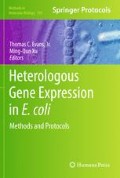Abstract
Heterologously expressed proteins in Escherichia coli may undergo unwanted N-terminal processing by methionine and proline aminopeptidases. To overcome this problem, we present a system where the gene of interest is cloned as a fusion to a self-splicing mini-intein. This fusion construct is expressed in an engineered E. coli strain from which the pepP gene coding for aminopeptidase P has been deleted. We describe a protocol using human cationic trypsinogen as an example to demonstrate that recombinant proteins produced in this expression system contain homogeneous, unprocessed N-termini.
Access this chapter
Tax calculation will be finalised at checkout
Purchases are for personal use only
References
Witt, H., Luck, W., Becker, M. (1999) A signal peptide cleavage site mutation in the cationic trypsinogen gene is strongly associated with chronic pancreatitis. Gastroenterology 117, 7–10.
Pfützer, R. H., Whitcomb, D. C. (1999) Trypsinogen mutations in chronic pancreatitis. Gastroenterology 117, 1507–1508.
Chen, J. M., Raguenes, O., Ferec, C., Deprez, P. H., Verellen-Dumoulin, C., Andriulli, A. (1999) The A16V signal peptide cleavage site mutation in the cationic trypsinogen gene and chronic pancreatitis. Gastroenterology 117, 1508–1509.
Teich, N., Bauer, N., Mössner, J., Keim, V. (2002) Mutational screening of patients with nonalcoholic chronic pancreatitis: identification of further trypsinogen variants. Am J Gastroenterol 97, 341–346.
Sahin-Tóth, M. (2000) Human cationic trypsinogen. Role of Asn-21 in zymogen activation and implications in hereditary pancreatitis. J Biol Chem 275, 22750–22755.
Sahin-Tóth, M., Tóth, M. (2000) Gain-of-function mutations associated with hereditary pancreatitis enhance autoactivation of human cationic trypsinogen. Biochem Biophys Res Commun 278, 286–289.
Ben-Bassat, A., Bauer, K., Chang, S. Y., Myambo, K., Boosman, A., Chang, S. (1987) Processing of the initiation methionine from proteins: properties of the Escherichia coli methionine aminopeptidase and its gene structure. J Bacteriol 169, 751–757.
Yaron, A., Mlynar, D. (1968) Aminopeptidase-P. Biochem Biophys Res Commun 32, 658–663.
Király, O., Guan, L., Szepessy, E., Tóth, M., Kukor, Z., Sahin-Tóth, M. (2006) Expression of human cationic trypsinogen with an authentic N terminus using intein-mediated splicing in aminopeptidase P deficient Escherichia coli. Protein Expr Purif 48, 104–111.
Wu, H., Xu, M. Q., Liu, X. Q. (1998) Protein trans-splicing and functional mini-inteins of a cyanobacterial dnaB intein. Biochim Biophys Acta 1387, 422–432.
Evans, T. C., Jr., Benner, J., Xu, M. Q. (1999) The cyclization and polymerization of bacterially expressed proteins using modified self-splicing inteins. J Biol Chem 274, 18359–18363.
Yoshimoto, T., Murayama, N., Honda, T., Tone, H., Tsuru, D. (1988) Cloning and expression of aminopeptidase P gene from Escherichia coli HB101 and characterization of expressed enzyme. J Biochem 104, 93–97.
Yoshimoto, T., Tone, H., Honda, T., Osatomi, K., Kobayashi, R., Tsuru, D. (1989) Sequencing and high expression of aminopeptidase P gene from Escherichia coli HB101. J Biochem 105, 412–416.
Datsenko, K. A., Wanner, B. L. (2000) One-step inactivation of chromosomal genes in Escherichia coli K-12 using PCR products. Proc Natl Acad Sci USA 97, 6640–6645.
Lengyel, Z., Pál, G., Sahin-Tóth, M. (1998) Affinity purification of recombinant trypsinogen using immobilized ecotin. Protein Expr Purif 12, 291–294.
Tabor, S., Richardson, C. C. (1985) A bacteriophage T7 RNA polymerase/promoter system for controlled exclusive expression of specific genes. Proc Natl Acad Sci USA 82, 1074–1078.
Pál, G., Sprengel, G., Patthy, A., Gráf, L. (1994) Alteration of the specificity of ecotin, an E. coli serine proteinase inhibitor, by site directed mutagenesis. FEBS Lett 342, 57–60.
Chung, C. H., Ives, H. E., Almeda, S., Goldberg, A. L. (1983) Purification from Escherichia coli of a periplasmic protein that is a potent inhibitor of pancreatic proteases. J Biol Chem 258, 11032–11038.
Neu, H. C., Heppel, L. A. (1965) The release of enzymes from Escherichia coli by osmotic shock and during the formation of spheroplasts. J Biol Chem 240, 3685–3692.
Aiyar, A., Xiang, Y., Leis, J. (1996) Site-directed mutagenesis using overlap extension PCR. Methods Mol Biol 57, 177–191.
Acknowledgments
We thank Barry L. Wanner (Department of Biological Sciences, Purdue University, West Lafayette, IN) for sharing the plasmids and bacterial strains of the Red recombinase-based gene deletion system. The valuable support and contributions of Ronald Kaback, Edit Szepessy, Zoltán Kukor, and Miklós Tóth are gratefully acknowledged. This work was supported by NIH Grant DK058088 to M.S.-T.
Author information
Authors and Affiliations
Corresponding author
Editor information
Editors and Affiliations
Rights and permissions
Copyright information
© 2011 Springer Science+Business Media, LLC
About this protocol
Cite this protocol
Király, O., Guan, L., Sahin-Tóth, M. (2011). Expression of Recombinant Proteins with Uniform N-Termini. In: Evans, Jr., T., Xu, MQ. (eds) Heterologous Gene Expression in E.coli. Methods in Molecular Biology, vol 705. Humana Press. https://doi.org/10.1007/978-1-61737-967-3_10
Download citation
DOI: https://doi.org/10.1007/978-1-61737-967-3_10
Published:
Publisher Name: Humana Press
Print ISBN: 978-1-61737-966-6
Online ISBN: 978-1-61737-967-3
eBook Packages: Springer Protocols

